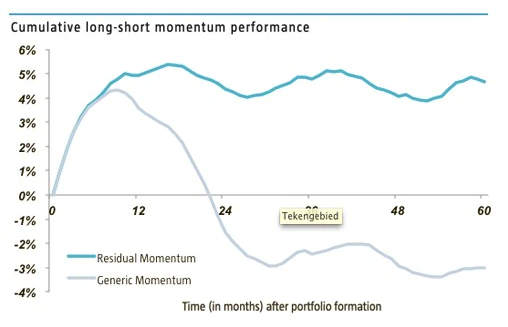The momentum effect is the tendency of stocks to show persistence in performance: stocks that performed well in the recent past, on average outperform other stocks in the subsequent period, while the opposite holds for stocks with poor returns.
While there is a vast amount of evidence on the existence of the momentum effect, there is still an ongoing academic debate on the source of the momentum premium. Behavioral explanations attribute momentum to either underreaction or overreaction.
Momentum is driven by over- or underreaction
Overreaction can be attributed to investors’ delayed overreaction to stock-specific news, herding behavior and return chasing behavior. Underreaction can be caused by investors’ underreaction to stock-specific news, as they rely too heavily on the first information available (anchoring bias) or diffuse the information slowly. Another explanation is that investors sometimes hold on to losers to avoid admitting mistakes while quickly selling winners to show success.
Momentum from overreaction: risk of price reversals
Identifying the source of a stock’s momentum, i.e. over- or underreaction, matters, because it gives insight into the expected risk and sustainability of a momentum strategy. A momentum strategy that buys a winner stock which suffers from overreaction causes upward price pressure on that stock, makes the price drift even further away from its intrinsic value and hence aggravates the mispricing. Sooner or later, the market will realize this and the price of the stock will revert towards its fundamental value. Hence, a strategy profiting from momentum driven by overreaction runs the risk of stock price reversals.
Leggi gli ultimi approfondimenti
Iscriviti alla nostra newsletter per ricevere aggiornamenti sugli investimenti e le analisi dei nostri esperti.
Momentum from underreaction: less risky, more sustainable
A strategy based on momentum from underreaction will lead to price pressure that actually diminishes the mispricing and is therefore not prone to reversals in stock prices. It is therefore less risky and more sustainable, because its return comes from making the market more rather than less efficient. We therefore prefer underreaction as a source of a momentum strategy.
Robeco quant models use momentum from underreaction
Robeco applies a proprietary ‘residualization’ technique that isolates the stock’s momentum that can be attributed to the stock-specific component and eliminates the part of a stock’s momentum that is due to its systematic component. This technique is applied to the momentum factor in all of Robeco’s quantitative stock selection models.
News that results in high total returns on stocks makes these stocks susceptible to overreaction, as investors start to chase returns and institutional investors are often constrained to stay close to their benchmarks. This does not hold for news that results in high stock-specific returns, as this does not necessarily lead to higher returns. That is why we expect overreaction to be the main driver of total return momentum and underreaction the primary source of Robeco’s residual, stock-specific momentum.
The graph below confirms that residual momentum is not prone to the price reversal associated with overreaction, unlike a generic total return momentum strategy.
Cumulative long-short momentum performance

Average cumulative performance after formation of long-short portfolios that start each month in the period January 1986 to December 2012 and are held for 60 months. The universe consists of the largest 3,000 constituents of the S&P Broad Market Index each month. A residual (generic) momentum portfolio consists of equal long/short positions in the top/bottom decile residual (generic) momentum stocks of the universe.


















